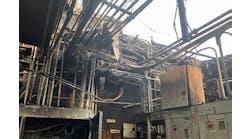5 ways to speed transformation during COVID-19
“Choosing a partner in the space is about speed, speed and speed—you want someone who knows the technology and also knows how to get it done.” Mick Mancuso of Rockwell Automation, shared five ways companies are accelerating digital transformation during the COVID-19 pandemic.
Enterprises have increased their adoption of digital manufacturing during the COVID-19 pandemic—and they’re not about to slow down. “We saw a little bit of a pause as the outbreak hit different parts of the world,” explained Mick Mancuso, director, Connected Enterprise operations, Rockwell Automation, who spoke at a press conference this week during the company’s Automation Fair At Home event. “Now, we’re only seeing acceleration. It is a business imperative now.”
Mancuso originally led the digital transformation for Rockwell Automation operations, and he now shares the expertise of lessons learned with customers to aid them in their journeys. He noted three important trends that are occurring during the pandemic.
First, more companies want to securely connect remote workers. “Turns out, manufacturing was already moving to social distancing,” he explained. “Whether it was IT, operations or engineering people, they wanted to be able to connect back to manufacturing and run manufacturing, even if it was from home. Obviously, we want to do that in a secure way. We also want to be able to see how things are going.”
The second trend is a continuing demand for automation. “There are new assets and new data points coming on-line,” explained Mancuso. “They’re being connected to the enterprise.”
And third is the idea of supply-chain resiliency. “The pandemic showed some gaps in supply chains,” said Mancuso. “Meanwhile, in certain industries, there’s been an uptick in demand. This is why digital transformation has been speeding along.”
Mancuso then shared five recommendations for expediting a digital transformation during the coronavirus pandemic.
- Get executive sponsorship. “We’re seeing executives get more involved,” said Mancuso. “Maybe before the pandemic there was a groundswell of support for digitalization, but now it’s important that executives are involved because transformation is really about the company’s culture.” When an executive isn’t involved, the implementation might focus on the technology itself or it might be siloed. “We’re seeing a champion, someone in the C suite, maybe even the CEO, become involved,” he explained.
- Build a cross-functional team. “Companies were moving in this direction before, but there were barriers and siloes,” said Mancuso. “Because of the pandemic, a lot of those barriers have been diminished. Everyone’s been pulling together very quickly to make those digital transformations a reality. IT and OT experts should be on the same team.”
- Define a plan. “A plan continues to be very important,” explained Mancuso. “What’s different now is that strategies need to be carefully thought out, even as companies try to move fast and quickly adapt to this new normal. What are the key business drivers? Change management is a big thing, especially in manufacturing. Having that change-management plan is really important. Meanwhile, success will come from adoption by employees.”
- Secure operational technology environments. “Securing the OT environment is as important as it’s ever been,” stressed Mancuso. “It’s enabling some opportunities for more risk. Whether it’s IT or OT, those cyber-threats continue to exist. It’s still as important as ever to have that secure environment. Usually OT environments have their own networks and different business priorities. You can’t afford a network outage because they’re operating 24x7.”
- Get the right technology and partners. “As we’ve hit this pandemic, having the right technology and partners has been an accelerator for many companies,” said Mancuso. Previously, there were a lot of internal activities with teams doing some deep analysis. “Now, getting that technology piece right and having the right partners has become really important,” he explained. “People are looking for future-proof technologies. Having the ability to scale is also really important. We’re looking at platform-based technology to help minimize the integration effort and maximize the scalability. Having an external partner can help to fill in those gaps. Choosing a partner in the space is about speed, speed and speed—you want someone who knows the technology and also knows how to get it done.”
Digital transformation, in turn, is enabling increased visibility into operations. “There are ways to get started quickly, say, with an IoT platform. Another way is with the connected worker. Imagine having someone out in the field who isn’t your most experienced person and connecting to someone with experience through augmented reality.” There’s value in being able to talk back and forth and being able to record this and share that. “We’re seeing a lot more use cases around using augmented-reality tools,” said Mancuso.
“When you’re thinking about how to future-proof your technology, take a platform-based approach,” he continued. “You can find point solutions for anything you want to solve, but holistic platforms can be applied to a variety of use cases—from work instructions or basic analytics to quality monitoring.”
Digital transformation is very important, concluded Mancuso. “As companies were in the very beginning stages of the pandemic, they were wondering if this was going to help them or not,” he said. “They now understand that they’re working in a different environment, and they need to be connected and informed. And we’re helping them to do just that.”
The editors of Control, Control Design and Smart Industry are providing coverage of Automation Fair At Home, bringing you breaking news, innovations and insights from the virtual event. Once Automation Fair At Home is over, the editors will put together an event report featuring the top news. Pre-order your copy today.






